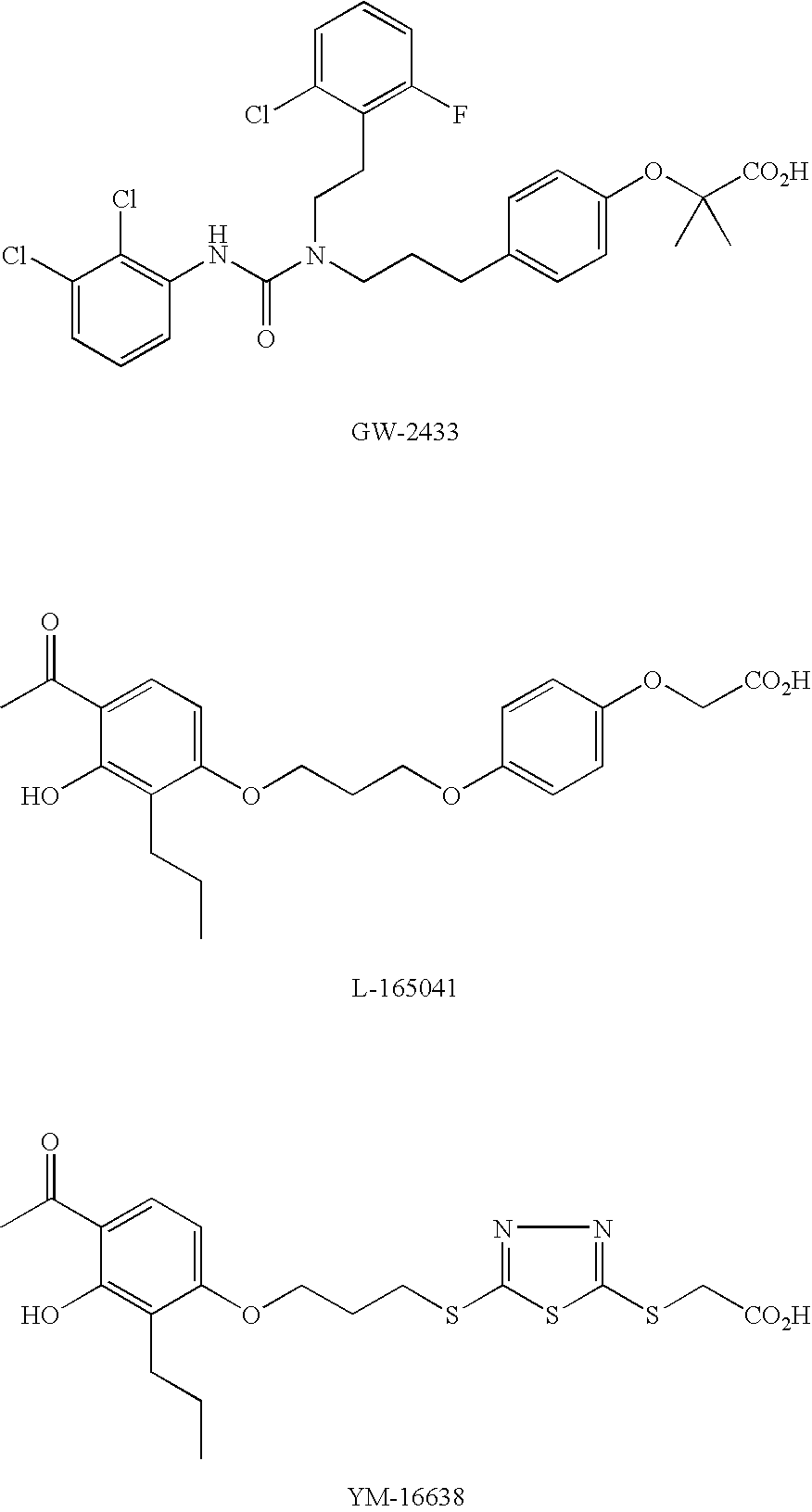Activator of peroxisome proliferator-activated receptor
- Summary
- Abstract
- Description
- Claims
- Application Information
AI Technical Summary
Benefits of technology
Problems solved by technology
Method used
Image
Examples
example 1
2-[4-[3-[2-(2,4-Dichlorophenyl)-5-isopropyl-4-oxazolyl]propionyl]-2-methylphenoxy]-2-methylpropionic acid
(1) 3-[2-(2,4-Dichlorophenyl)-5-isopropyl-4-oxazolyl]-1-(3-methyl-4-hydroxyphenyl)propan-1-one
To an ice-cold THF (5 mL) was added 60% sodium hydride (97 mg, 2.42 mmol). Subsequently, a solution of ethyl 2-[(3-methyl-4-benzyloxy)benzoyl]acetate (757 mg, 2.42 mmol) in THF (4 mL) was dropwise added for 30 minutes. The mixture was allowed to room temperature, and then stirred for 30 minutes. To the mixture was added 4-iodomethyl-5-isopropyl-2-(2,4-dichlorophenyl)oxazole (960 mg, 2.42 mmol). The resulting mixture was refluxed for 20 hours under nitrogen atmosphere, and allowed to room temperature. THF was removed under reduced pressure. To the residue was added acetic acid (6.4 mL)-conc. hydrochloric acid (1.6 mL), and the mixture was refluxed for 10 hours, and allowed to room temperature. The reaction mixture was poured into ice water. Ethyl acetate was added to the mixture. The o...
example 2
[4-[3-[2-(2,4-Dichlorophenyl)-5-isopropyl-4-oxazolyl]propionyl]-2-methylphenoxy]acetic acid
(1) Ethyl [4-[3-[2-(2,4-dichlorophenyl)-5-isopropyl-4-oxazolyl]propionyl]-2-methylphenoxy]acetate
The synthetic intermediate of Example 1, namely 3-[2-(2,4-dichlorophenyl)-5-isopropyl-4-oxazolyl]-1-(3-methyl-4-hydroxyphenyl)propan-1-one (105 mg, 0.25 mmol) and potassium carbonate (103 mg, 0.75 mmol) were suspended in acetone (3 mL). Ethyl bromoacetate (0.08 mL, 0.75 mmol) was added to the suspension while cooling with ice. The suspension was allowed to room temperature, and refluxed while heating for 6 hours. Insolubles were filtered, and washed with acetone. Subsequently, the solvent was distilled off. The residue was purified by column chromatography on silica gel with hexane / ethyl acetate (7 / 1-4 / 1) to give the subject compound (117 mg) as colorless oil (yield 92%)
1H-NMR (CDCl3, 400 MHz) δ: 1.26(t, 3H, J=7 Hz), 1.30(d, 6H, J=7 Hz), 2.31(s, 3H), 2.75(t, 2H, J=7 Hz), 3.18(dq, 1H, J=7 Hz, J=...
example 3
[4-[3-[2-(4-Trifluoromethyl)phenyl-4-isopropyl-5-thiazolyl]propionyl]-2-methylphenoxy]acetic acid
(1) 3-[2-(4-Trifluoromethyl)phenyl-4-isopropyl-5-thiazolyl]-1-(3-methyl-4-hydroxyphenyl)propan-1-one
To an ice-cold THF (5 mL) was added 60% sodium hydride (27 mg, 0.67 mmol). Subsequently, a solution of ethyl 2-[(3-methyl-4-benzyloxy)benzoyl]acetate (190 mg, 0.61 mmol) in THF (3 mL) was dropwise added for 30 minutes. The mixture was allowed to room temperature, and then stirred for 30 minutes. To the mixture was added 5-iodomethyl-4-isopropyl-2-(4-trifluoromethyl)phenylthiazole (250 mg, 0.61 mmol). The resulting mixture was refluxed for 20 hours under nitrogen atmosphere, and allowed to room temperature. THF was removed under reduced pressure. To the residue was added acetic acid (3.2 mL)-conc. hydrochloric acid (0.8 mL), and the mixture was refluxed for 10 hours under heating, and allowed to room temperature. The reaction mixture was poured into ice water. The mixture was extracted w...
PUM
| Property | Measurement | Unit |
|---|---|---|
| Fraction | aaaaa | aaaaa |
| Fraction | aaaaa | aaaaa |
| Fraction | aaaaa | aaaaa |
Abstract
Description
Claims
Application Information
 Login to View More
Login to View More - R&D
- Intellectual Property
- Life Sciences
- Materials
- Tech Scout
- Unparalleled Data Quality
- Higher Quality Content
- 60% Fewer Hallucinations
Browse by: Latest US Patents, China's latest patents, Technical Efficacy Thesaurus, Application Domain, Technology Topic, Popular Technical Reports.
© 2025 PatSnap. All rights reserved.Legal|Privacy policy|Modern Slavery Act Transparency Statement|Sitemap|About US| Contact US: help@patsnap.com



